
views
Hooking up a Pedal

Insert a 9-volt battery into the pedal to power it. Remove the screws on the sides or bottom of the pedal by turning them counterclockwise. Then, slide off the faceplate to gain access to the 9-volt battery hook up on the bottom of the pedal. Connect the negative and positive ends of the battery hook up with the negative and positive ends of the battery to power your pedal. If you use batteries, you don't have to plug the pedal into a power source. Some pedals have a red warning light that turns on when the batteries are low. Refer to the instruction manual that came with the pedal if you're unsure of how to access the battery hookup for your specific pedal.

Plug the pedal into the wall instead of using batteries. If you don't want to run the risk of your batteries dying while you play, you can also connect your effects pedal directly into an AC outlet in your home. The 9-volt power cord input is usually found on the top or side of the pedal. Purchase a 9-volt power cord online or at a guitar store.

Plug a guitar cord into the output jack on your pedal. Most pedals and amps use a ⁄4 inch (6.4 mm) guitar cord. Insert one end of the cord into the output jack on your pedal. This cord must be long enough to connect from the pedal to your amp. It doesn't matter which end of the cord you plug into the pedal.

String multiple pedals together for different sounds. You can hook up multiple pedals by connecting them with a guitar cord. Plug the cord coming from the output jack of one pedal and plug it into the input jack of the second pedal. You can string together as many pedals as you want using this method. Using more than one pedal at the same time will mix the effects together.
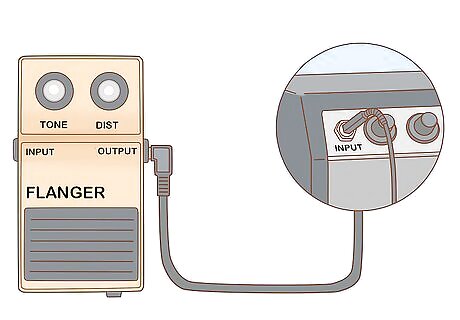
Connect the other end of the cord into the input jack on your amp. Take the same cord that's connected to the output jack on your pedal, and plug the other end of the cord into the input jack on the amp. The wire should run from the pedal to the amp. If you are using multiple pedals, connect the last pedal in your lineup to the amp.
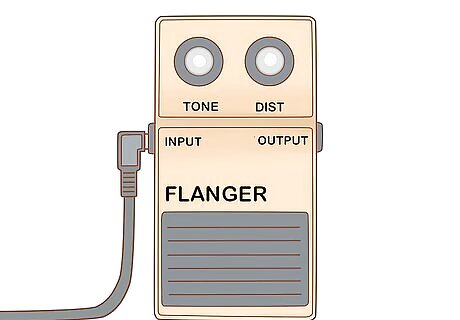
Insert a guitar cord into the input jack on the pedal. Use another, separate guitar cord, and plug it into the input jack on your pedal. This guitar cord must be long enough to reach from the pedal to your guitar.
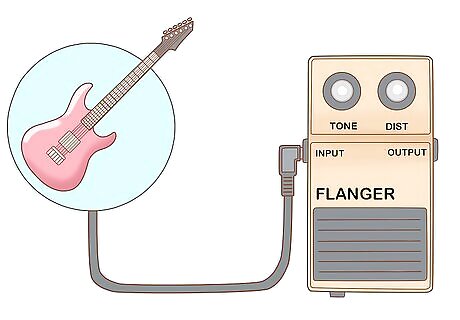
Insert the opposite end of the cord into your guitar. The jack for the cord on your guitar can usually be found on the body of the guitar. Take the opposite end of the cord that's inserted into the input jack on your pedal and put it into the single jack on your guitar. Your effects pedal is now set up.
Playing Guitar with an Effects Pedal
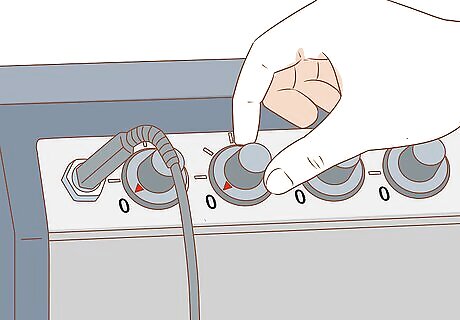
Turn down the volume when using pedals that affect volume and gain. Effects pedals like overdrive and boost may greatly increase the frequency, volume, and gain when playing your guitar. Turn down the volume on your amp so that you don't blow out the speakers once you start playing notes.
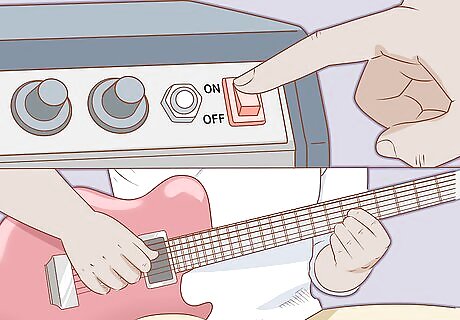
Flip your amp on and strum a string. Flip the switch on the front of the amp to the on position. Play a note on your guitar. It should sound the same way that it would if you connected the guitar directly to the amp because the pedal isn't engaged yet. If no sound is coming out of your amp, make sure that the cords connecting the pedal to the guitar and amp are correctly plugged in and are in good working order.
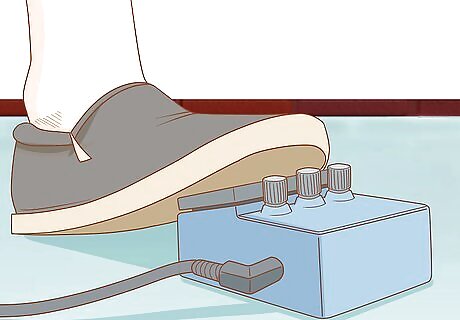
Press on the pedal with your foot to turn on the effects pedal. Pressing down on the pedal will engage the effects and should distort and change the way that the guitar sounds coming out of the amp. Try playing something that you'd normally play and take notice of the different sound. You can play an entire song with the effects pedal or hit it on during a specific part of a song to change the sound of your guitar.

Adjust the knobs to change the sound of the pedal. Each pedal will come with different knobs that affect the sound of the distortion, volume, and intensity of the distortion. Experiment with the knobs by turning them up and down as you play notes to see how it changes the sound of your guitar. Turning the tone knob up will increase the sound of treble in your guitar, while turning it down will increase the bass of the guitar. Turning up the drive knob on an overdrive pedal will increase the distortion.
Choosing the Right Pedal
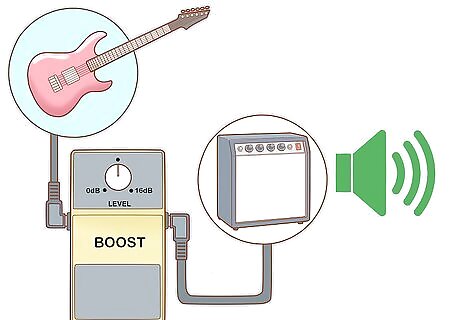
Use a boost pedal to increase the volume of your guitar. A boost pedal increases the signal of your guitar for a louder sound and more sustained gain. Gain is the buildup of sound that occurs after you strike a note. If you're using a lower voltage amp or just want to boost the volume and gain of your guitar, you should use this pedal. Boost pedals are often used in conjunction with overdrive or distortion pedals.
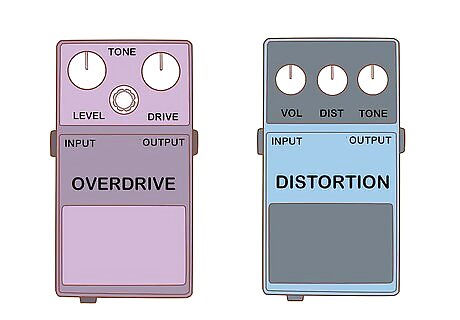
Use an overdrive or distortion pedal for a heavy metal or punk sound. Overdrive and distortion pedals add sustain and a “crunch” to the sound of your guitar. These pedals are often used when playing heavy metal or punk songs that contain power chords. Use this pedal if you want a distorted rock sound. Set your amp to the cleanest setting if you use a distorted pedal. You don't want to have your amp set to distortion while using a distortion pedal on top of it.
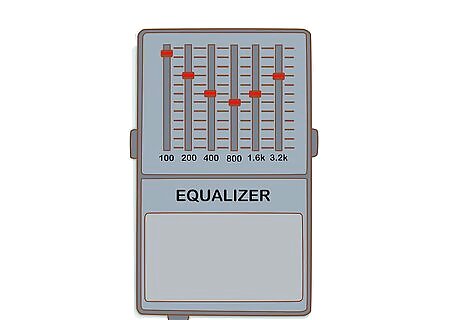
Get an equalizer to adjust the tone of your guitar. You can adjust the bass and treble of your guitar with an equalizer or EQ pedal. Adjust the knobs or sliders up and down to change the frequency of your guitar. Unlike distortion or overdrive pedals, EQ pedals allow you to change multiple frequencies when playing your guitar.
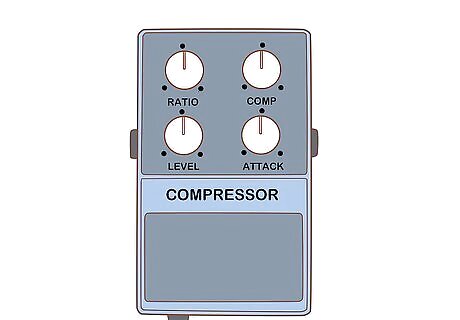
Get a compressor to control the tone and sustain of your sound. Compressors typically have tone, attack, and sustain knobs which let you control different aspects of your guitar's sound. Compressors even out the sound as you're playing, which makes for more consistent volumes and sustain. Compressors allow you to set a range so that your guitar is never at too high or low of a frequency. A high attack will highlight the initial plucking of the string. Sustain controls how long the note rings out after you play it.
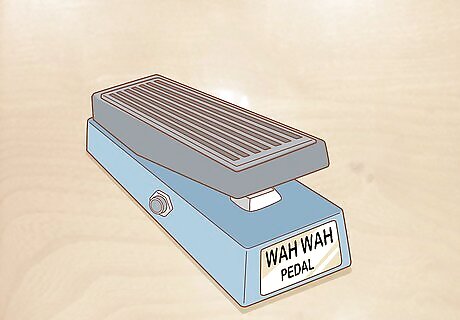
Use a wah-wah pedal to change frequency as you play. A wah-wah pedal fluctuates the frequency of your guitar up and down as you play. Rock your foot back and forth on the pedal to achieve the “wah-wah” sound. Pressing down on the pedal with your toes will increase the treble and frequency of your notes, whereas pressing down on the pedal with your heel will increase the bass.
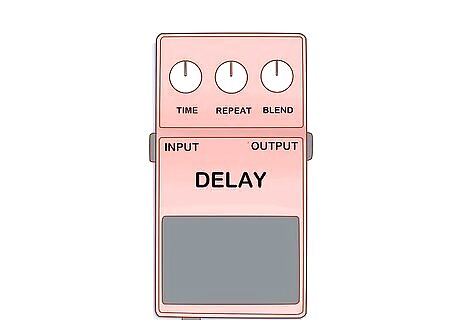
Hook up a delay pedal to hear an echo when you play. A delay will repeat the notes that you played back in an echo over time. With a delay pedal, you can adjust the delay time and frequency to achieve different sounds.
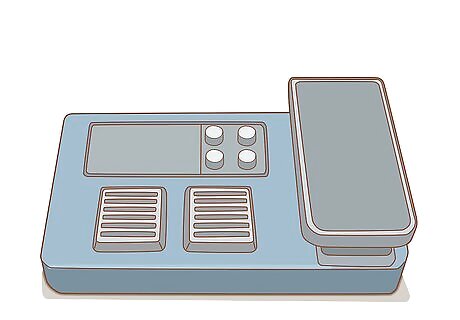
Get a multi-effects pedal for a range of effects. If you want a wide range of effects, you can get a single multi-effect pedal that includes a variety of different effects. Multi-effects pedals don't offer the same level of customization as using individual pedals because they come with preset effects that you can't swap out. However, if you plan on using multi-effects in your play, they can save you money in the long run.











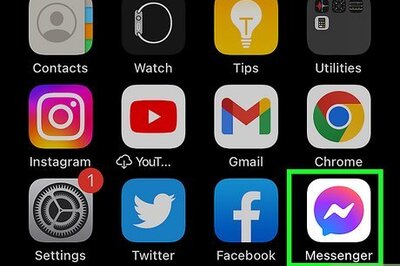




Comments
0 comment